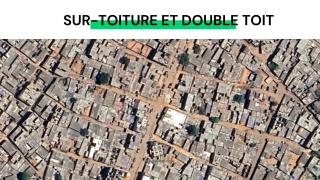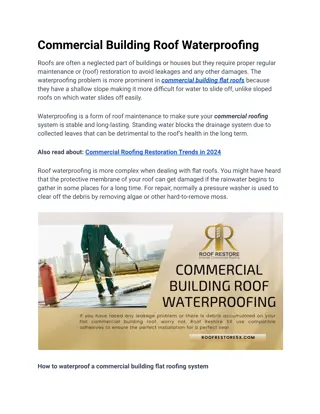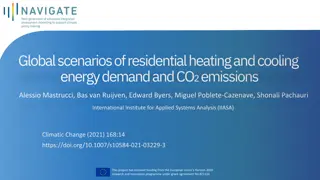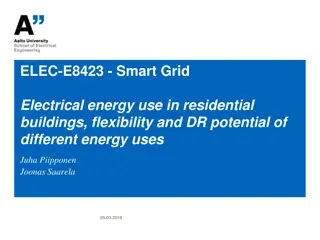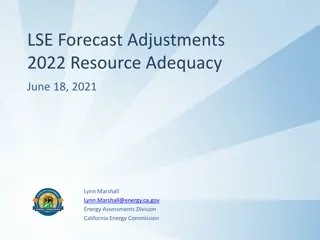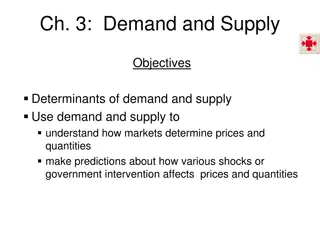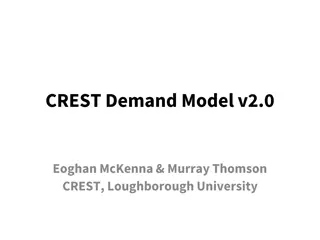The Hidden Benefit of Cool Roofs in Reducing Peak Energy Demand
Commercial building owners can reduce peak energy demand by installing cool roofs, leading to lower electricity costs and environmental benefits. Peak energy demand can strain the power grid, require additional capacity, and result in higher electricity rates. By understanding base use and peak demand charges, building owners can better manage their electrical consumption and optimize cost savings. The relationship between base use and peak demand is crucial in controlling overall energy expenses. Proper management of peak demand can contribute to a more sustainable and efficient energy system.
Uploaded on Sep 06, 2024 | 0 Views
Download Presentation

Please find below an Image/Link to download the presentation.
The content on the website is provided AS IS for your information and personal use only. It may not be sold, licensed, or shared on other websites without obtaining consent from the author. Download presentation by click this link. If you encounter any issues during the download, it is possible that the publisher has removed the file from their server.
E N D
Presentation Transcript
Reducing Peak Energy Demand: The Hidden Benefit of Cool Roofs Dr. James L. Hoff, DBA, TEGNOS Research, Inc., Keith Gere and Robert Carnick, Duro-Last Inc. November 11, 2014
Peak Energy Demand 30,000 +33% 25,000 20,000 MW 15,000 3:00 PM 10,000 6:00 PM 8:00 AM 5,000 0 1 2 3 4 5 6 7 8 9 10 11 12 13 14 15 16 17 18 19 20 21 22 23 24 Hourly Electrical Demand New England ISO Region, July 22, 2011 Source: U. S. Energy Information Administration / ISO New England
Peak Energy Demand 30,000 Daytime HVAC 25,000 20,000 Daytime Lighting & Equipment MW 15,000 3:00 PM Base Demand 10,000 6:00 PM 8:00 AM 5,000 0 1 2 3 4 5 6 7 8 9 10 11 12 13 14 15 16 17 18 19 20 21 22 23 24 Hourly Electrical Demand New England ISO Region, July 22, 2011 Source: U. S. Energy Information Administration / ISO New England
Peak Energy Demand Requires additional power plant capacity Reduces overall capacity utilization and return on investment Causes imbalances in the power grid Increases air pollution at a critical period of the day May result in monthly charges many times higher than base electricity rates
How Commercial Building Owners Pay for Peak Demand Two Distinct Types of Charges: 1. Base Use: Measured in total kWh used 2. Peak Demand: Measured in highest kW measured during peak periods
Base Use and Peak Demand 50 60 40 70 MPH 30 80 20 90 4 10 100 0345765 110 0 Miles Driven = Base Use (kWh) Top Speed = Peak Demand (kW)
Typical Commercial Electric Bill Name/Service Address For Inquiries Call Account Number Acme Enterprises Attn: Accounting Dept. 123 Main Street Hanover, IN 47243 Duke Energy 1-800-655-5555 For Account Services, please contact Betty Smith 0000-1234-05-6 Meter Reading Previous Present Actual kW Reading Date From To Meter Number Days Usage Elec 012345600 144441 15860 120.00 29 56,780 Jun 28 Jul 27 Duke Energy Rate HSND High Load Factor Sec S/v Other Charges & Credits Demand Charge 120.00 kW @ Energy Charge 56,780 kWh @ Rider 60 Fuel Adjustment 56,780 kWh @ Rider 61 Coal Gasification Adj 120.00 kW @ Rider 62 Pollution Control Adj 120.00 kW @ Rider 63 Emission Allowance 120.00 kW @ Rider 66 DSM Ongoing 56,780 kWh @ Rider 68 Midwest Ind Sys Oper Adj 56,780 kWh @ Rider 70 Reliability Adjustment 56,780 kWh @ Rider 71 Clean Coal Adjustment 120.00 kW @ 8.12 $ 14.0600000 1,687.20 $ 0.01683000 955.61 $ 0.01420700 806.67 $ 1.91436100 229.72 $ 2.04057600 244.87 $0.00032300 18.34 $ 0.00021600 12.26 $ 0.00072500 41.17 $ 0.00035700 20.27 $ 4,274.38 $ 2.06452600 250.14 $ 4,274.38 4,274.38 Total Current Electric Charges Source: Duke Energy of Indiana
Typical Commercial Electric Bill Name/Service Address For Inquiries Call Account Number Acme Enterprises Attn: Accounting Dept. 123 Main Street Hanover, IN 47243 Duke Energy 1-800-655-5555 For Account Services, please contact Betty Smith 0000-1234-05-6 Total Base Use: Meter Reading Previous Present Actual kW Reading Date From To Meter Number Days Usage 120.00 144441 15860 Elec 012345600 Jun 28 Jul 27 29 56,780 Duke Energy Rate HSND High Load Factor Sec S/v Base Use (kWh) $1854.32 Other Charges & Credits Demand Charge 120.00 kW @ Energy Charge 56,780 kWh @ Rider 60 Fuel Adjustment 56,780 kWh @ Rider 61 Coal Gasification Adj 120.00 kW @ Rider 62 Pollution Control Adj 120.00 kW @ Rider 63 Emission Allowance 120.00 kW @ Rider 66 DSM Ongoing 56,780 kWh @ Rider 68 Midwest Ind Sys Oper Adj 56,780 kWh @ Rider 70 Reliability Adjustment 56,780 kWh @ Rider 71 Clean Coal Adjustment 120.00 kW @ 8.12 $ 14.0600000 1,687.20 Base Use Charges $ 0.01683000 955.61 $0.0330 / kWh $ 0.01420700 806.67 $ 1.91436100 229.72 $ 2.04057600 244.87 44% of Monthly Bill $0.00032300 18.34 $ 0.00021600 12.26 $ 0.00072500 41.17 $ 0.00035700 20.27 $ 2.06452600 250.14 $ 4,274.38 $ 4,274.38 4,274.38 Total Current Electric Charges Source: Duke Energy of Indiana
Typical Commercial Electric Bill Name/Service Address For Inquiries Call Account Number Acme Enterprises Attn: Accounting Dept. 123 Main Street Hanover, IN 47243 Duke Energy 1-800-655-5555 For Account Services, please contact Betty Smith 0000-1234-05-6 Total Peak Demand: Meter Reading Previous Present Actual kW Reading Date From To Meter Number Days Usage $2441.94 144441 15860 120.00 Elec 012345600 Jun 28 Jul 27 29 56,780 Duke Energy Rate HSND High Load Factor Sec S/v Peak Demand (kW) 8.12 Other Charges & Credits Demand Charge 120.00 kW @ Energy Charge 56,780 kWh @ Rider 60 Fuel Adjustment 56,780 kWh @ Rider 61 Coal Gassification Adj 120.00 kW @ Rider 62 Pollution Control Adj 120.00 kW @ Rider 63 Emission Allowance 120.00 kW @ Rider 66 DSM Ongoing 56,780 kWh @ Rider 68 Midwest Ind Sys Oper Adj 56,780 kWh @ Rider 70 Reliability Adjustment 56,780 kWh @ Rider 71 Clean Coal Adjustment 120.00 kW @ $20.10 / kW Peak Demand Charges $ 14.0600000 1,687.20 $ 0.01683000 955.61 $ 0.01420700 806.67 56% of Monthly Bill $ 1.91436100 229.72 $ 2.04057600 244.87 $0.00032300 18.34 $ 0.00021600 12.26 $ 0.00072500 41.17 $ 0.00035700 20.27 $ 2.06452600 250.14 $ 4,274.38 $ 4,274.38 4,274.38 Total Current Electric Charges Source: Duke Energy of Indiana
Typical Commercial Electric Bill Name/Service Address For Inquiries Call Account Number Acme Enterprises Attn: Accounting Dept. 123 Main Street Hanover, IN 47243 Duke Energy 1-800-655-5555 For Account Services, please contact Betty Smith 0000-1234-05-6 Total Base Use: Total Peak Demand: Total Net Billing: $0.0330 / kWh $20.10 / kW $0.075 / kWh Meter Reading Previous Present Actual kW Reading Date From To Meter Number Days Usage 144441 15860 120.00 Elec 012345600 Jun 28 Jul 27 29 56,780 Duke Energy Rate HSND High Load Factor Sec S/v Base Use (kWh) Peak Demand (kW) 8.12 Other Charges & Credits Demand Charge 120.00 kW @ Energy Charge 56,780 kWh @ Rider 60 Fuel Adjustment 56,780 kWh @ Rider 61 Coal Gassification Adj 120.00 kW @ Rider 62 Pollution Control Adj 120.00 kW @ Rider 63 Emission Allowance 120.00 kW @ Rider 66 DSM Ongoing 56,780 kWh @ Rider 68 Midwest Ind Sys Oper Adj 56,780 kWh @ Rider 70 Reliability Adjustment 56,780 kWh @ Rider 71 Clean Coal Adjustment 120.00 kW @ $ 14.0600000 1,687.20 $ 0.01683000 955.61 $ 0.01420700 806.67 Peak Demand Charges Base Use Charges $ 1.91436100 229.72 $ 2.04057600 244.87 $0.00032300 18.34 $ 0.00021600 12.26 $ 0.00072500 41.17 $ 0.00035700 20.27 $ 2.06452600 250.14 $ 4,274.38 $ 4,274.38 4,274.38 Total Current Electric Charges Source: Duke Energy of Indiana
Reducing Peak Energy Demand Equipment Improvements Lighting Improvements Supplemental Daylighting & Solar Reduced Peak Solar Loads
Cool Reflective Roofing A Non-Reflective Roof Absorbs the Majority of Solar Heat and Transfers it into the Building A Cool Reflective Roof Reflects the Majority of Solar Heat and Directs it Away from the Building
Cool Reflective Roof Standards Minimum Roof Reflectance Initial Reference Standard Aged International Energy Conservation Code (2012) 70% 55% ASHRAE 90.1 Energy Standard for Buildings (2011) 70% 55% Energy Star for Roofs (U.S. EPA, 2012) 65% 50% California Title 24 Energy Standard (2012) n/a 63%
Peak Demand Not Just a Warm Climate Issue Peak Cooling Season ( 6 Months +/-) 1.2 Monthly / Annual Maximum Demand 1 0.8 0.6 0.4 0.2 0 JAN FEB MAR APR MAY JUN JUL AUG SEP OCT NOV DEC Phoenix Minneapolis Roof-Related Air Conditioning Demand: Ratio of Monthly to Annual Peak Source: Oak Ridge National Laboratories
Peak Demand Savings Uniform Through All Climate Zones Warmest Climate Zones Coldest Climate Zones 3.0 PHOENIX 2.5 2.0 BTU / 100 Ft2 MINNEAPOLIS 1.5 1.0 0.5 0.0 -0.5 Zone 1 Zone 2 Base Use Savings Zone 3 Zone 4 Peak Demand Savings Zone 5 Zone 6 Zone 7-8 Potential Roof-Related Base Use and Peak Demand Savings (by North America Climate Zone) Source: RoofPoint Energy and Carbon Calculator
Calculating Peak Demand Savings DOE Cool Roof Peak Calculator Developed by Oak Ridge National Laboratories for U.S. Department of Energy Based on extensive research and modeling of over 200 locations across North America Models the most typical commercial roofing system with above-deck insulation Compares a cool roof against a nominal black roof with 5% reflectivity Available online at no charge
Using the DOE Cool Roof Peak Calculator Step 1: Go to Cool Roof Peak Calculator Web Page DOE Cool Roof Peak Calculator (http://web.ornl.gov/sci/roofs+walls/facts/CoolCalcPeak.htm) My State Select a State My City Select a City My Proposed Roof: R-value (HIGH=20; AVG=10; LOW=5) [h ft F/Btu] Solar reflectance, SR (HIGH=80; AVG=50; LOW=10) [%] Infrared emittance, IE (HIGH=90; AVG=60; LOW=10) [%] My Energy Costs and Equipment Efficiencies: Summertime cost of electricity (HIGH=0.20; AVG=0.10; LOW=0.05) [$/KWh] http://web.ornl.gov/sci/roofs+ walls/facts/CoolCalcPeak.htm Air conditioner efficiency (COP) over cooling season (HIGH=2.5; AVG=2.0; LOW=1.5) Energy source for heating (choose one) If electricity, wintertime cost (HIGH=0.20; AVG=0.10; LOW=0.05) [$/KWh] If fuel, cost (Natural gas: HIGH=1.00; AVG=0.70; LOW=0.50) [$/Therm] (Fuel oil: 2002 East coast=0.85; 2002 Midwest=0.70) [$/Therm] Heating system efficiency (Furnace or boiler: HIGH=0.8; AVG=0.7; LOW=0.5) (Electric heat pump: HIGH=2.0; AVG=1.5) (Electric resistance: 1.0) My Electricity Demand Charges and Duration: Demand charge during cooling season (HIGH=15.00; AVG=10.00; LOW=5.00) [$/KW] Months charged for peak demand (Typical = 6) [-] Total Annual Energy + Demand Savings (relative to a black roof) [$/ft per year] Cooling energy savings [$/ft per year] Heating energy savings (heating penalty if negative) [$/ft per year] Cooling season demand savings [$/ft per year]
Using the DOE Cool Roof Peak Calculator DOE Cool Roof Peak Calculator (http://web.ornl.gov/sci/roofs+walls/facts/CoolCalcPeak.htm) Step 2: Select city and state from over 200 locations My State Select a State My City Select a City My Proposed Roof: R-value (HIGH=20; AVG=10; LOW=5) [h ft F/Btu] Solar reflectance, SR (HIGH=80; AVG=50; LOW=10) [%] Infrared emittance, IE (HIGH=90; AVG=60; LOW=10) [%] My Energy Costs and Equipment Efficiencies: Summertime cost of electricity (HIGH=0.20; AVG=0.10; LOW=0.05) [$/KWh] Air conditioner efficiency (COP) over cooling season (HIGH=2.5; AVG=2.0; LOW=1.5) Energy source for heating (choose one) If electricity, wintertime cost (HIGH=0.20; AVG=0.10; LOW=0.05) [$/KWh] If fuel, cost (Natural gas: HIGH=1.00; AVG=0.70; LOW=0.50) [$/Therm] (Fuel oil: 2002 East coast=0.85; 2002 Midwest=0.70) [$/Therm] Heating system efficiency (Furnace or boiler: HIGH=0.8; AVG=0.7; LOW=0.5) (Electric heat pump: HIGH=2.0; AVG=1.5) (Electric resistance: 1.0) My Electricity Demand Charges and Duration: Demand charge during cooling season (HIGH=15.00; AVG=10.00; LOW=5.00) [$/KW] Months charged for peak demand (Typical = 6) [-] Total Annual Energy + Demand Savings (relative to a black roof) [$/ft per year] Cooling energy savings [$/ft per year] Heating energy savings (heating penalty if negative) [$/ft per year] Cooling season demand savings [$/ft per year]
Using the DOE Cool Roof Peak Calculator DOE Cool Roof Peak Calculator (http://web.ornl.gov/sci/roofs+walls/facts/CoolCalcPeak.htm) My State Select a State My City Select a City Step 3: Enter proposed roof R-value My Proposed Roof: R-value (HIGH=20; AVG=10; LOW=5) [h ft F/Btu] Solar reflectance, SR (HIGH=80; AVG=50; LOW=10) [%] Infrared emittance, IE (HIGH=90; AVG=60; LOW=10) [%] My Energy Costs and Equipment Efficiencies: Summertime cost of electricity (HIGH=0.20; AVG=0.10; LOW=0.05) [$/KWh] Air conditioner efficiency (COP) over cooling season (HIGH=2.5; AVG=2.0; LOW=1.5) Energy source for heating (choose one) If electricity, wintertime cost (HIGH=0.20; AVG=0.10; LOW=0.05) [$/KWh] If fuel, cost (Natural gas: HIGH=1.00; AVG=0.70; LOW=0.50) [$/Therm] (Fuel oil: 2002 East coast=0.85; 2002 Midwest=0.70) [$/Therm] Heating system efficiency (Furnace or boiler: HIGH=0.8; AVG=0.7; LOW=0.5) (Electric heat pump: HIGH=2.0; AVG=1.5) (Electric resistance: 1.0) My Electricity Demand Charges and Duration: Demand charge during cooling season (HIGH=15.00; AVG=10.00; LOW=5.00) [$/KW] Months charged for peak demand (Typical = 6) [-] Total Annual Energy + Demand Savings (relative to a black roof) [$/ft per year] Cooling energy savings [$/ft per year] Heating energy savings (heating penalty if negative) [$/ft per year] Cooling season demand savings [$/ft per year]
Using the DOE Cool Roof Peak Calculator DOE Cool Roof Peak Calculator (http://web.ornl.gov/sci/roofs+walls/facts/CoolCalcPeak.htm) My State Select a State My City Select a City My Proposed Roof: R-value (HIGH=20; AVG=10; LOW=5) [h ft F/Btu] Step 4: Enter proposed roof solar reflectance (SR) and thermal emittance (TE) Solar reflectance, SR (HIGH=80; AVG=50; LOW=10) [%] Infrared emittance, IE (HIGH=90; AVG=60; LOW=10) [%] My Energy Costs and Equipment Efficiencies: Summertime cost of electricity (HIGH=0.20; AVG=0.10; LOW=0.05) [$/KWh] Air conditioner efficiency (COP) over cooling season (HIGH=2.5; AVG=2.0; LOW=1.5) Energy source for heating (choose one) If electricity, wintertime cost (HIGH=0.20; AVG=0.10; LOW=0.05) [$/KWh] If fuel, cost (Natural gas: HIGH=1.00; AVG=0.70; LOW=0.50) [$/Therm] (Fuel oil: 2002 East coast=0.85; 2002 Midwest=0.70) [$/Therm] Heating system efficiency (Furnace or boiler: HIGH=0.8; AVG=0.7; LOW=0.5) (Electric heat pump: HIGH=2.0; AVG=1.5) (Electric resistance: 1.0) My Electricity Demand Charges and Duration: Demand charge during cooling season (HIGH=15.00; AVG=10.00; LOW=5.00) [$/KW] Months charged for peak demand (Typical = 6) [-] Total Annual Energy + Demand Savings (relative to a black roof) [$/ft per year] Cooling energy savings [$/ft per year] Heating energy savings (heating penalty if negative) [$/ft per year] Cooling season demand savings [$/ft per year]
Using the DOE Cool Roof Peak Calculator DOE Cool Roof Peak Calculator (http://web.ornl.gov/sci/roofs+walls/facts/CoolCalcPeak.htm) My State Select a State My City Select a City My Proposed Roof: R-value (HIGH=20; AVG=10; LOW=5) [h ft F/Btu] Solar reflectance, SR (HIGH=80; AVG=50; LOW=10) [%] Infrared emittance, IE (HIGH=90; AVG=60; LOW=10) [%] Step 5: Enter cost of heating and cooling energy and equipment efficiencies My Energy Costs and Equipment Efficiencies: Summertime cost of electricity (HIGH=0.20; AVG=0.10; LOW=0.05) [$/KWh] Air conditioner efficiency (COP) over cooling season (HIGH=2.5; AVG=2.0; LOW=1.5) Energy source for heating (choose one) If electricity, wintertime cost (HIGH=0.20; AVG=0.10; LOW=0.05) [$/KWh] If fuel, cost (Natural gas: HIGH=1.00; AVG=0.70; LOW=0.50) [$/Therm] (Fuel oil: 2002 East coast=0.85; 2002 Midwest=0.70) [$/Therm] Heating system efficiency (Furnace or boiler: HIGH=0.8; AVG=0.7; LOW=0.5) (Electric heat pump: HIGH=2.0; AVG=1.5) (Electric resistance: 1.0) My Electricity Demand Charges and Duration: Demand charge during cooling season (HIGH=15.00; AVG=10.00; LOW=5.00) [$/KW] Months charged for peak demand (Typical = 6) [-] Total Annual Energy + Demand Savings (relative to a black roof) [$/ft per year] Cooling energy savings [$/ft per year] Heating energy savings (heating penalty if negative) [$/ft per year] Cooling season demand savings [$/ft per year]
Using the DOE Cool Roof Peak Calculator DOE Cool Roof Peak Calculator (http://web.ornl.gov/sci/roofs+walls/facts/CoolCalcPeak.htm) My State Select a State My City Select a City My Proposed Roof: R-value (HIGH=20; AVG=10; LOW=5) [h ft F/Btu] Solar reflectance, SR (HIGH=80; AVG=50; LOW=10) [%] Infrared emittance, IE (HIGH=90; AVG=60; LOW=10) [%] My Energy Costs and Equipment Efficiencies: Summertime cost of electricity (HIGH=0.20; AVG=0.10; LOW=0.05) [$/KWh] Air conditioner efficiency (COP) over cooling season (HIGH=2.5; AVG=2.0; LOW=1.5) Energy source for heating (choose one) If electricity, wintertime cost (HIGH=0.20; AVG=0.10; LOW=0.05) [$/KWh] If fuel, cost (Natural gas: HIGH=1.00; AVG=0.70; LOW=0.50) [$/Therm] (Fuel oil: 2002 East coast=0.85; 2002 Midwest=0.70) [$/Therm] Heating system efficiency (Furnace or boiler: HIGH=0.8; AVG=0.7; LOW=0.5) (Electric heat pump: HIGH=2.0; AVG=1.5) (Electric resistance: 1.0) My Electricity Demand Charges and Duration: Demand charge during cooling season (HIGH=15.00; AVG=10.00; LOW=5.00) [$/KW] Months charged for peak demand (Typical = 6) [-] Step 6: Enter electric demand charge and duration (typically 6 months) Total Annual Energy + Demand Savings (relative to a black roof) [$/ft per year] Cooling energy savings [$/ft per year] Heating energy savings (heating penalty if negative) [$/ft per year] Cooling season demand savings [$/ft per year]
Using the DOE Cool Roof Peak Calculator DOE Cool Roof Peak Calculator (http://web.ornl.gov/sci/roofs+walls/facts/CoolCalcPeak.htm) My State Select a State My City Select a City My Proposed Roof: R-value (HIGH=20; AVG=10; LOW=5) [h ft F/Btu] Solar reflectance, SR (HIGH=80; AVG=50; LOW=10) [%] Infrared emittance, IE (HIGH=90; AVG=60; LOW=10) [%] My Energy Costs and Equipment Efficiencies: Summertime cost of electricity (HIGH=0.20; AVG=0.10; LOW=0.05) [$/KWh] Air conditioner efficiency (COP) over cooling season (HIGH=2.5; AVG=2.0; LOW=1.5) Energy source for heating (choose one) If electricity, wintertime cost (HIGH=0.20; AVG=0.10; LOW=0.05) [$/KWh] If fuel, cost (Natural gas: HIGH=1.00; AVG=0.70; LOW=0.50) [$/Therm] (Fuel oil: 2002 East coast=0.85; 2002 Midwest=0.70) [$/Therm] Step 7: View the savings: Total cooling savings Heating penalty (if any) Cooling season demand savings Heating system efficiency (Furnace or boiler: HIGH=0.8; AVG=0.7; LOW=0.5) (Electric heat pump: HIGH=2.0; AVG=1.5) (Electric resistance: 1.0) My Electricity Demand Charges and Duration: Demand charge during cooling season (HIGH=15.00; AVG=10.00; LOW=5.00) [$/KW] Months charged for peak demand (Typical = 6) [-] Total Annual Energy + Demand Savings (relative to a black roof) [$/ft per year] Cooling energy savings [$/ft per year] Heating energy savings (heating penalty if negative) [$/ft per year] Cooling season demand savings [$/ft per year]
Applying the Cool Roof Peak Calculator Model Study Composite of model cities in each North American climate zone Representative commercial building 20,000 square foot low-rise structure Heated and cooled with typical HVAC equipment (AC C.O.P. = 2.0, Furnace Efficiency = 0.70) Two construction conditions / insulation levels New insulation meeting 2012 IECC insulation levels Old insulation meeting pre-2012 IECC levels Cool roof solar reflectance (SR) = 0.60 / thermal emittance (TE) = 0.90 Solar reflectance (SR) = 0.60 Thermal emittance (TE) = 0.90 Compared to black roof with SR=0.05 and TE = 0.90 Electrical base use and demand charge identical to sample energy bill Base use: $0.033 / kWh Demand Charge: $20.10 / kW Plus natural gas for heating at $0.70 / Therm
Cool Roof Model Study Climate Zones and Model Cities Climate Climate Zone Zone 1 2 3 4 5 6 7-8 Model Model Cities Cities Miami (FL) Houston (TX), Phoenix (AZ) Atlanta (GA), Dallas (TX) St. Louis (MO), Baltimore (MD) Chicago (IL), Pittsburgh (PA) Milwaukee (WI), Minneapolis (MN) Duluth (MN)
Cool Roof Model Study Climate Zones and R-Values Roof R Roof R- -Value New Insulation Condition2 Value Climate Zone Old Insulation Condition1 1 2 3 4 5 6 7-8 10 15 15 15 15 15 15 20 20 20 25 25 30 35 Notes: 1. Per 2006 International Energy Conservation Code 2. Per 2012 International Energy Conservation Code
Cool Roof Model Study New Insulation Results $2,000 $2,000 Base Use Savings Base Use Savings Peak Demand Savings Peak Demand Savings $1,640 $1,640 $1,500 $1,500 $1,340 $1,340 1,270 1,270 $1,000 $950 $950 $1,000 $1,000 $800 $800 $960 $620 $620 $1,000 $280 $280 $800 $500 $500 $800 $700 $640 $600 $380 $270 $150 $0 $0 $0 -$80 -$320 -$500 -$500 Zone 1 Zone 1 R20 R20 R20 Zone 2 Zone 2 R20 R20 Zone 3 Zone 3 R20 R25 Zone 4 Zone 4 R25 R25 Zone 5 Zone 5 R25 R30 R35 R30 R35 Zone 6 Zone 6 Zone 7 Zone 7 Estimated Net Energy Savings: Cool Roof Installed over New Insulation (Annual Dollars / 20,000 Square Foot Roof Area)
Cool Roof Model Study Old Insulation Results $3,040 $3,000 Base Use Savings Peak Demand Savings $2,500 $2,250 $1,600 $1,870 $2,000 $1,490 $1,400 $1,500 $1,220 $1,150 $880 $1,360 $1,000 $1,280 $1,440 $1,220 $1,200 $1,200 $500 $850 $510 $210 $0 $0 -$50 -$320 -$500 Zone 1 R10 R15 R15 R15 R15 R15 R15 Zone 2 Zone 3 Zone 4 Zone 5 Zone 6 Zone 7 Estimated Net Energy Savings: Cool Roof Installed over Old Insulation (Annual Dollars / 20,000 Square Foot Roof Area)
The Bottom Line: Cool Roofs and Peak Energy Demand Potential savings available in all climates and conditions studied Zone 1 through Zone 8 New roofs or roof recovers All levels of roof insulation Peak demand drives the potential savings Over 50% in all climate zones Up to 100% in the coolest climate zones
Peak Demand and the Building Design Professional The Next Steps Get to know your clients electrical bills No substitute for actual bills Calculate actual base and peak charges Don t simply divide the total bill by kWh usage Start using the DOE Cool Roof Peak Calculator Don t rely on tools that only use a single average rate in lieu of base and peak rates Build the results into your roof designs Base new roof and recover roof designs on total base and peak energy modeling
Reducing Peak Energy Demand: The Hidden Benefit of Cool Roofs Dr. James L. Hoff, DBA, TEGNOS Research, Inc., Keith Gere and Robert Carnick, Duro-Last Inc.



